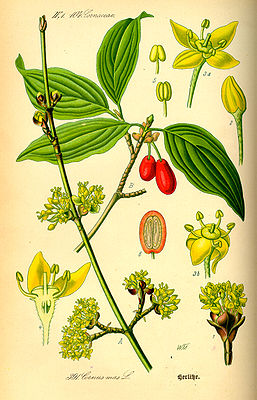Dogwood-like
| Dogwood-like | ||||||||||||
|---|---|---|---|---|---|---|---|---|---|---|---|---|

Cornelian cherry ( Cornus mas ), illustration. |
||||||||||||
| Systematics | ||||||||||||
|
||||||||||||
| Scientific name | ||||||||||||
| Cornales | ||||||||||||
| link |
Dogwood-like (Cornales) are an order within the flowering plants (Magnoliopsida).
description
There are shrubs , half-shrubs , vines or herbaceous plants . They have opposite or alternate, evergreen or annually falling, mostly undivided leaves . The inflorescences are cymes or grapes . The single flowers are usually fourfold and radial symmetry , hermaphroditic or unisexual. The stamens are free. The ovaries are subordinate. The fruits are berries or drupe-like false fruits.
distribution
The dogwood-like have their distribution from the temperate latitudes to the subtropics : They have their main distribution in the northern temperate latitudes ( Holarctic ) and in the subtropics. In the Neotropic they occur from Mexico to Chile , especially in the Andes .
Systematics
The Cornales are the most basal order within the asterids and thus the sister group of all other asterids.
In the order Cornales there are seven families with about 51 genera and about 590 species:
- Dogwood family (Cornaceae): It contains only two genera with around 85 species.
- Curtisiaceae: It contains only one genus:
- Curtisia : They are evergreen trees of two kinds, in southern Africa.
- Grubbiaceae: It contains only one genus:
- Hydrangeaceae : It contains around 17 genera and 220 species.
- Hydrostachyaceae: It contains only one genus:
- Hydrostachys : The 20 to 30 species occur in southern Africa and Madagascar. They are rosette-shaped underwater plants
- Flower nettle family (Loasaceae): It contains around 14 genera with around 265 species. Mainly native to the New World , but also taxa in Africa and the Marquesas Islands .
- Tupelo family (Nyssaceae): It contains about five genera with about 22 species. In the Tertiary they were still very species-rich, but are only present in relicts today. With disjoint area : East Asia and eastern North America.
swell
- The order of Cornales in APWebsite . (engl.)
Individual evidence
- ↑ Angiosperm Phylogeny Group : An update of the Angiosperm Phylogeny Group classification for the orders and families of flowering plants: APG III. In: Botanical Journal of the Linnean Society. Volume 161, No. 2, 2009, pp. 105-121, DOI: 10.1111 / j.1095-8339.2009.00996.x .
- ↑ The Angiosperm Phylogeny Group: An update of the Angiosperm Phylogeny Group classification for the orders and families of flowering plants: APG IV . Botanical Journal of the Linnean Society, 2016, Volume 181, pp. 1-20. doi : 10.1111 / boj.12385